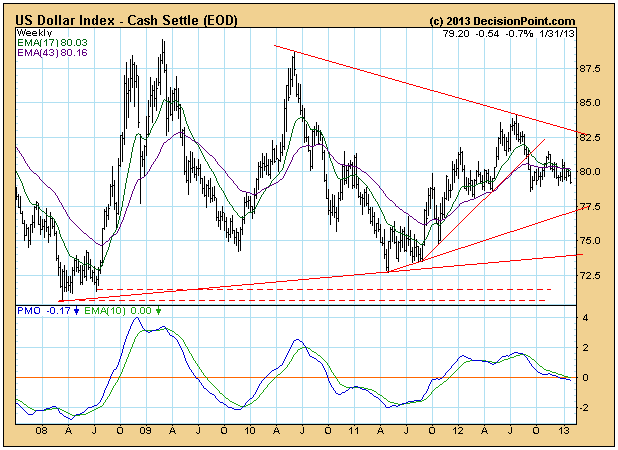Futures Indexes Versus ETFs
READER QUESTION: I am always curious why you elect to use a surrogate of a market to provide a technical analysis. The one I have a concern with is using UUP to analyze a H&S formation and mention violation of support. However, the actual dollar chart shows that support still holds.
CARL’S ANSWER: The first reason is that we don’t have access to spot prices on commodities because of the expense of getting a data feed from the commodities exchanges. What we have available are futures-based indexes, such as $USD (Dollar Index), $USB (30-Year T-Bond), and $WTIC (Crude Oil), which report daily prices for the near futures contract. The problem is that, as the near contract nears expiration, the index begins tracking the next nearest contract, which is normally has a different price. These monthly rollovers cause a lack of continuity in historical prices, similar to stock prices that are not adjusted for splits and distributions, and the usefulness of these indexes for the purpose of technical analysis is somewhat degraded to say the least.
The other reason we use ETFs for our analysis is that an ETF most accurately depicts that actual cost of trading the commodity. It includes transaction costs, the cost of rolling from one contract to another, etc. Also, basically, you can’t trade the index, but you can trade the ETF.
(This is a recent excerpt from the blog for Decision Point subscribers.)
. . . than the ETF (UUP).
Conclusion: We prefer to use ETFs instead of futures-based indexes because they more accurately reflect the the results of running a fund for a given commodity. Most important, the technical analysis we apply to the ETF has practical value, since the ETF can be traded.
* * * * * * * * * * * * * * * * * * * * *
Technical analysis is a windsock, not a crystal ball.
* * * * * * * * * * * * * * * * * * * * *
Carl Swenlin is a self-taught technical analyst, who has been involved in market analysis since 1981. A pioneer in the creation of online technical resources, he is president and founder of DecisionPoint.com, a premier technical analysis website specializing in stock market timing, market indicators, charting, and focused research reports. Mr. Swenlin is a Member of the Market Technicians Association.




Recent Comments